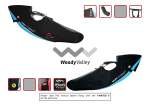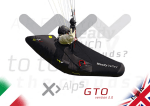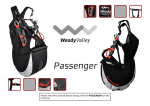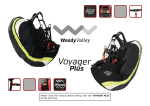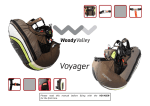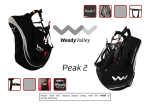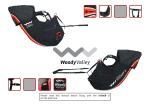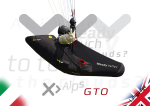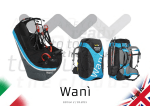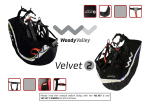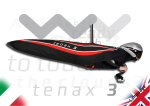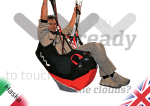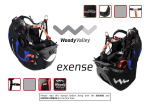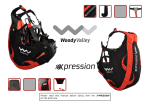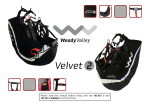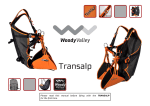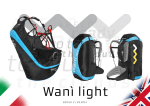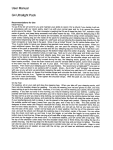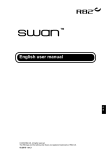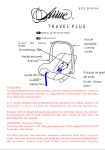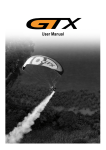Download THANK YOU!
Transcript
THANK YOU! We would like to thank you for having chosen one of our products, and we invite you to read this important document, the User Manual for the harness. Please pay special attention to the two most important paragraphs, regarding: Insertion of the reserve parachute. The reserve parachute is a piece of equipment that may save your life. It must be treated so that it works correctly when it is required, whether this happens in two days’ time, or two years from now. Adjusting the harness. The harness forms the connection between the pilot and the paraglider, and it is an essential component in optimizing performance and the pleasure of flying. A bad harness that is well adjusted may enable you to fly well, but a good harness that is badly adjusted may put you off flying altogether. We are confident that this harness will give you greater comfort, control, performance and enjoyment in flight. We are conscious of the fact that reading an instruction manual is not an exciting experience. However, please remember that the respective product is not a citrus juicer or a mobile phone, and that correct use of the harness helps reduce the risk of flying accidents. This manual contains all the information necessary to assemble, adjust, fly and store your harness. Thorough knowledge of your equipment will improve your personal safety and your level of flying. The Woody Valley team SAFETY NOTE You have purchased a piece of equipment manufactured by us, and so you are aware of your identity as a paraglider pilot holding the respective pilot’s licence, and you accept all the risks connected to paragliding including the possibility of injury and death. The incorrect or inappropriate use of Woody Valley equipment greatly increases this risk. In no case can Woody Valley and the Woody Valley retailer be held responsible for personal injury caused to yourself or to third parties, or for whatever type of damage. If you have any doubts on the use of our equipment, please contact your retailer or the importer for your country. INDEX 1- GENERAL INFORMATION ..................................................................................................................................................................................... 1 1.1- CONCEPT ...............................................................................................................................................................................................................................................1 1.2- X-ALPS PROTECTION ..........................................................................................................................................................................................................................2 2- BEFORE USING THE HARNESS ............................................................................................................................................................................ 2 2.1- EMERGENCY PARACHUTE .....................................................................................................................................................................................................................2 2.1.1- Connecting the deployment handle to the deployment bag ........................................................................................................................................2 2.1.2- Connecting the emergency parachute to the harness ..................................................................................................................................................3 2.1.3- Inserting the emergency parachute ...................................................................................................................................................................................5 2.1.4- Reserve parachute deployment...........................................................................................................................................................................................7 2.1.5- Back storage pocket................................................................................................................................................................................................................7 2.2- HARNESS ADJUSTMENTS .....................................................................................................................................................................................................................9 2.2.1- Adjusting seat and back position...................................................................................................................................................................................... 10 2.2.2- Shoulder strap adjustment................................................................................................................................................................................................ 11 2.2.3- Chest strap adjustment ...................................................................................................................................................................................................... 12 2.2.4- Adjusting the emergency parachute container and cockpit ..................................................................................................................................... 12 2.2.5- Leg strap adjustment .......................................................................................................................................................................................................... 12 2.2.6- Stabilizer ................................................................................................................................................................................................................................. 13 2.2.7- ABS adjustment .................................................................................................................................................................................................................... 13 2.2.8- Leg cover adjustment.......................................................................................................................................................................................................... 14 2.2.9- Speed-bar adjustment ........................................................................................................................................................................................................ 15 3- FLYING WITH THE X-ALPS HARNESS................................................................................................................................................................ 16 3.1- PRE-FLIGHT CHECKS ......................................................................................................................................................................................................................... 16 3.2- POCKETS ............................................................................................................................................................................................................................................ 16 3.3- FLYING ABOVE WATER ....................................................................................................................................................................................................................... 16 3.4- AERO-TOWING HOOK ......................................................................................................................................................................................................................... 17 3.5- LANDING WITH THE X-ALPS HARNESS............................................................................................................................................................................................. 17 4- PACKING THE HARNESS.................................................................................................................................................................................... 17 5- MAINTENANCE AND REPAIRS........................................................................................................................................................................... 18 6- TECHNICAL SPECIFICATIONS ............................................................................................................................................................................ 20 1- GENERAL INFORMATION This equipment should contain: Harness Polycarbonate seat plate Composite foot plate Hook-in karabiners Emergency parachute deployment handle Two spare elastic loops for fastening the emergency parachute container Three-step speed-bar Bridle Rucsac 1.1- Concept X-ALPS was created principally for the like-named paragliding competition, but its light weight, convenience and dynamic performance have made it popular with all pilots who like para-trekking. In addition, its geometry and active flying characteristics make it ideal for cross-country pilots, and in fact this harness was designed for maximum comfort and simplicity of use. As it was created specifically for this type of competition, and with the objective of reducing weight and bulk as far as possible, it does not have any back protection. Even though the harness cannot be given certification, because of the lack of back protection, its structural frame has in any case passed the breaking strength test performed as part of the LTF procedure. Its low aerodynamic drag considerably improves the performance of competition paragliders. The leg straps and chest strap are fitted with the “GET-UP safety system” which prevents the pilot from sliding out of the harness in the case that he or she forgets to fasten the leg straps. 1 1.2- X-ALPS protection IMPORTANT: - X-ALPS is not fitted with back protection. 2- BEFORE USING THE HARNESS X-ALPS must be assembled by a qualified paragliding professional, such as your instructor. More specifically, great care has to be dedicated to inserting the reserve parachute into the harness in the correct way. Only after this has been performed should the pilot adjust the harness for maximum comfort. 2.1- Emergency parachute The emergency parachute container is in the ventral section. The container was designed for very light emergency parachutes, with a lower volume than standard chutes. The parachute has to be connected to the bridle provided before inserting it into the ventral container. The bridle splits into two straps which are fastened to the main harness karabiners. With this type of link between the emergency parachute and the harness, the emergency parachute can be deployed from left or from right. 2.1.1- Connecting the deployment handle to the deployment bag X-ALPS is supplied complete with the handle for parachute deployment, marked as n° 13; this deployment handle only should be used. The black loop on the handle should be put through the loop attached to the deployment bag, and then the entire handle should be passed through the handle’s loop in order to link the two. In this harness, to facilitate deployment, we recommend linking the handle to the loop situated in the central part of the deployment bag. If your deployment bag does not have this loop, please contact your emergency parachute retailer. 2 2.1.2- Connecting the emergency parachute to the harness There are two methods for connecting the emergency parachute bridle to the harness risers. First system: Use a karabiner with a screw collar and a breaking strength of at least 2000 kg. In this case, the emergency parachute risers should be held in position within the karabiner using elastic bands, to prevent the karabiner from rotating into a lateral position which could cause it to undergo a dangerous lateral stress in the case of deployment. The screw collar should be tightened very firmly to prevent accidental opening. This type of connection can withstand a higher shock on deployment than the second system, and it is without doubt the best system to use. 3 Second system: The reserve parachute bridle is passed through the loop at the end of the harness reserve parachute bridle. The reserve parachute itself is then passed through the large loop in the reserve parachute bridle. This connects the two bridles. The loops should be pulled as tight as possible to avoid any chance of dangerous friction developing between the two bridles during the shock caused when the reserve parachute opens. To ensure that the link between the two bridles remains tight, remember to fasten the knot using the Velcro strip on the harness reserve parachute bridle. 4 2.1.3- Inserting the emergency parachute Fasten the emergency parachute bridle using the two Velcro strips inside the parachute container, ensuring that the two loops leading to the main karabiners are on opposite sides and emerge from the cockpit symmetrically, therefore with the same length. These two loops also make it possible to adjust the height of the container. We recommend fastening the Velcro as shown in the photo, in other words with the edge at the extremity of the container. If this is not satisfactory, remove the emergency parachute and repeat the steps as described below. Then carefully arrange the bridle inside the container. Insert the parachute into the harness container so that the deployment handle is visible and facing outwards, and with the loop that connects the handle to the deployment back facing upwards. Thread a thin cord (such as a paraglider shroud line) into each elastic loop. This will make it easier to close the container. 5 Insert the elastic loops into the smaller grommets (smaller with respect to the others on the edge of the container). Close the flaps in the order shown in the drawings/photos below. Inset the metal pins into the elastic loops, and insert the handle under the fabric flaps. The thin cord must be removed after completing this step. It should be drawn out slowly in order not to damage the elastic loops by excessive friction. Lastly, connect the right-hand loop of the emergency parachute bridle to the right-hand main karabiner. 6 IMPORTANT: - Each new combination of emergency parachute and harness or emergency parachute container to be assembled for the first time should be checked to ensure that the emergency parachute can be correctly deployed, by an official harness or emergency parachute dealer, or by a flight instructor. Emergency parachute deployment should be perfectly feasible from the normal flying position. 2.1.4- Reserve parachute deployment It is vital to feel periodically for the position of the reserve parachute deployment handle during normal flight, so that the action of reaching for the reserve parachute handle becomes instinctive in an emergency. In emergency situations, the deployment procedure is as follows: Look for the reserve parachute handle and grasp it firmly with one hand. Pull the handle outwards in order to extract the reserve parachute from the harness container. Look for a clear area, and, in a continuous motion, throw the reserve parachute away from yourself and the paraglider. After the reserve parachute has opened, avoid entanglement by pulling in the paraglider, gripping at least one D line, or the brake lines, in order to collapse the glider. On landing, adopt an upright body position, and ensure that you perform a PLF (Parachute Landing Fall) to minimize the risk of injury. 2.1.5- Back storage pocket To reach the back storage pocket, first of all you have to completely open the zip on the aerodynamic part of the harness towards the rear, and then turn over the aerodynamic tip. This will provide access to the storage pocket, which is opened by means of another zip. This pocket was specially designed with a size and shape suitable for a pair of telescopic walking poles (maximum length 67 cm in the L size), as well as the rucsac and a windcheater jacket: in other words, the equipment required by a hiker. The tips of the telescopic walking poles should be inserted into the metal grommets at the bottom of the pocket, as shown in the photo. To close the pocket and the aerodynamic part of the harness, just close the two zips. 7 IMPORTANT: - Overfilling the back pocket could prevent the correct inflation of the aerodynamic part of the harness. - Arrange the objects evenly throughout the entire space of the dorsal pocket, so that the harness profile is not deformed. - Do not place any objects inside between the inflatable section and the pocket. - Remember to close the zip of the aerodynamic part of the harness, in order to ensure correct inflation. 8 2.2- Harness adjustments X-ALPS is supplied already adjusted to a standard ergonomic setting, apart from adjustments required for pilot height. Therefore, for the first flight we recommend adjusting the harness for height alone, leaving the other settings unchanged, because they have proved to be satisfactory for the vast majority of pilots. If you wish to change the other settings, remember that you can always return to the factory settings by making reference to the red marks on all adjustment straps. Please remember that the size of your X-ALPS harness should be chosen according to your height, and not according to seat width. Unlike a harness based on a fundamentally seated position, in which the height of the seat back is not essential for good comfort, in this harness the pilot flies in a more supine position, and so the height of the back support is very important for good comfort and a correct flying position. Therefore it is important to select the right size, in particular as regards the height of the seat back, without worrying about the seat width. To adjust the harness to the optimum position, we recommend simulating flight position by hanging the harness from a suitable fixed point, therefore with all the items that you normally carry in flight inserted into the back pocket. IMPORTANT: - Before making any adjustments, the emergency parachute must be inserted. - Every adjustment must be made symmetrically on both sides. - Every adjustment strap has to be tight. 9 2.2.1- Adjusting seat and back position This photo shows how the lateral adjustments are arranged, and the many points at which the pilot is actually supported, from the upper back down to the lumbar area. All these adjustments improve pilot support and enable the harness to be adjusted to all back types. In the detail photo, adjustment n° 1 changes the angle between thighs and back (seat depth), distributing load between seat and the lumbar area and thus improving pilot comfort. Adjustment n° 3 is that which is principally used to alter the angle between the torso and the vertical. Adjustments n° 2 and n° 4 are useful for fine back adjustments, but they are secondary adjustments that improve contact between the harness back and the pilot’s back, improving support and comfort. 10 If you wish to work on the adjustments, the first strap should be loosened before adjusting the main strap to the point of optimum comfort. Once you have completed these steps, tighten the covering strap again in order to lock the adjustment setting. 2.2.2- Shoulder strap adjustment Shoulder-strap adjustment enables the harness to be adjusted to the pilot’s height. The adjustment buckle is situated low down, near the rear edge of the seat. The shoulder-straps also support part of the torso weight to improve comfort. After that you have determined the correct position for the seat and back, adjust the shoulder straps so that they are in contact with your shoulders, neither too loose nor too tight. 11 2.2.3- Chest strap adjustment The chest strap which controls the distance between the two karabiners can be adjusted from 40 to 55 cm. For the first flight with X-ALPS, we suggest setting the chest strap to the minimum length, then locating the preferred length in flight by means of gradual adjustment. When the chest strap is shorter and tighter, stability is greater. An excessive distance between karabiners does not improve glider performance, and tightening the chest strap excessively may exacerbate the "twist" effect that may follow an asymmetric collapse of the sail. 2.2.4- Adjusting the emergency parachute container and cockpit To adjust the height of the emergency parachute container, the Velcro strips have to be moved from the bridle to inside the container. Follow the instructions provided in paragraph 2.1.3. 2.2.5- Leg strap adjustment The roots of the leg straps are positioned high, a characteristic of the Get-Up system, and this ensures great freedom of movement for the legs. Generally, the factory settings are correct. If it is difficult to enter the harness after launch, we suggest tightening the leg strap adjustment under the seat. This makes it easier for the pilot to enter the harness after launch without having to let go of the paraglider’s control handles. 12 2.2.6- Stabilizer This small but important adjustment makes it possible to stabilize the harness when you exert pressure on the speed-bar, preventing excessive tilt of the back. Its mode of operation is very simple: when you push the speed-bar, this small plastic buckle blocks the shoulderstraps at the point at which they slide in the chest strap, making the entire strap system more rigid and improving overall harness stability. This adjustment is correctly set by the manufacturer. 2.2.7- ABS adjustment This adjustment affect flying performance. The looser it is, the less stable the harness becomes, and therefore the more sensitive to pilot movements. Vice versa, the tighter it is adjusted, the more stable the harness becomes, requiring more pronounced pilot movements in flight. X-ALPS is supplied with this adjustment set to a position that is suitable for most pilots. If you wish to change this setting, take great care and make very small changes, just a few millimetres every time. Ensure that adjustments are made with absolute symmetry. 13 2.2.8- Leg cover adjustment The leg cover can be adjusted for length by means of four small white spheres inside the cover, shown in the illustration below. The footrest is set for an approximately 90° ankle angle, the most natural and comfortable. Leg cover length can be extended or shortened according to the pilot’s requirements, maintaining symmetry of settings. 14 2.2.9- Speed-bar adjustment X-ALPS includes a three-step speed-bar, made with slim fabric webbing to decrease harness weight. The length of the speed-bar system should be adjusted only after the optimum harness adjustments have been completed. To set the speed-bar correctly, the pilot should sit in the harness in a simulator, hook in to the paraglider risers, and, with a helper supporting the risers, adjust the length of the speed-bar straps. When released, the footrest should be no more than 10 cm below the frontal part of the harness. Shortening the cord excessively could cause the speed-system to be constantly under tension and therefore unintentionally operational during the flight. It is safer to begin by launching with the speed-bar a little too long, shortening it progressively on the next flights. It is important to perform each adjustment symmetrically, in other words equal on both sides. If you wish to change the footrest, we can inform you that this harness can be used with all normal types of speed-bar. The footrest cords should be threaded first through the loops fixed to the elastic cord at mid-seat, on through the pulleys near the back corners of the seat, and then up to the fastening points on the paraglider risers, passing through the small grommets in the leg cover. In addition, the two elastic cords that Woody Valley supplies with all its speed-bar/footrests have to be fitted. These elastic cords should be fastened, with simple knots, to the two loops on the underside of the footrest. This ensures that the speed-system is always properly extended and ready for use. 15 3- FLYING WITH THE X-ALPS HARNESS 3.1- Pre-flight checks For maximum safety, use a complete and thorough sequence of pre-flight checks, and use the same sequence of checks every flight. Ensure that: the two chest-strap buckles are fastened. Take great care particularly in the presence of snow or ice, and remove the snow or ice before fastening the buckles; the bridle loops are correctly inserted into the karabiners; the emergency parachute deployment handle is in the correct position, with the pins properly inserted; all pockets and zips are closed; the paraglider is correctly hooked to the harness, and that both karabiners are locked closed by the respective locking mechanism; the speed-bar is correctly fitted to the paraglider. 3.2- Pockets X-ALPS has a back pocket and three side pockets. One of the side pockets is located near the main left karabiner and has a safety loop; it can be used to hold a small radio or a mobile phone. The other two pockets are positioned on the sides of the leg cover. 3.3- Flying above water There are no specific problems connected to flying above water using an X-ALPS harness, but in any case, landing in water is always dangerous. Woody Valley recommends using a suitable lifejacket when flying above water. 16 3.4- Aero-towing hook The X-ALPS harness can be used for towed launches. The tow bridle release should be hooked directly to the main karabiners, ensuring that the karabiners are positioned with the opening bar facing the rear. For further details, refer to the documentation provided with your tow release, or ask a qualified towing instructor at your flying site. 3.5- Landing with the X-ALPS harness During landing, remember to bring your legs out of the front cover and to adopt a standing position. Never land in a seated position, because this is very dangerous for your back. 4- PACKING THE HARNESS To pack the harness correctly and ensure that it takes up as least space as possible, we recommend following the steps shown in the photos below. Lay the harness on the ground, with the emergency parachute container facing out. Fold in the two upper sides of the harness, and then fold the leg cover upwards and onto the upper sides. Then fold the harness tail in half, so that it lies on the full height of the back. Lastly, fold the back against the seat, keeping the emergency parachute container facing outwards. After having folded the paraglider carefully, place it into the rucsac, and then put in the harness. Above this, place the emergency parachute container. Close the rucsac almost completely, leaving just the top open in order to put in your helmet and other garments if required. On the left side of the harness there is another pocket for telescopic walking poles. 17 5- MAINTENANCE AND REPAIRS Check the harness after every impact, bad landing or launch, or in the case that there are signs of damage or excessive wear. We recommend having your harness checked by your retailer every two years, and replacing the main karabiners every two years. To prevent unnecessary wear and deterioration of the harness, it is important to avoid its scraping against the ground, rocks or abrasive surfaces. Do not expose the harness unnecessarily to UV radiation (sunlight) outside normal flying activities. Wherever possible, protect the harness from humidity and heat. Store all your paragliding equipment in a cool, dry place, and never put it away while damp or wet. Keep your harness as clean as possible by regularly cleaning off dirt with a plastic bristle brush and/or a damp cloth. If the harness gets exceptionally dirty, wash it with water and a mild soap. Allow the harness to dry naturally in a well-ventilated area away from direct sunlight. If your reserve parachute ever gets wet (e.g. in a water landing) you must remove it from the harness, dry it and repack it before putting it back in the container. Repairs and replacement of harness components cannot be performed by the user, but exclusively by the manufacturer or staff authorized by the manufacturer. The manufacturer and authorized service staff alone can use materials and techniques ensuring correct product functionality and its complete conformity to product certification. 18 The harness can be washed using a tepid solution of water and mild soap. Zip fasteners should be kept clean and lubricated with silicone spray. In the case of making any request to an official retailer or Woody Valley for maintenance operations, please quote the complete identification number shown on the silver label in the rear pocket. This harness was designed to be as light as possible. The materials used in its construction are of excellent quality, but are lighter in terms of unit fabric weight than in a standard harness. For this reason, take great care when using and packing the X-ALPS harness. Correct use will extend the harness’ effective duration. In any case, the life of this harness will not be long as a standard harness built using heavier materials. We hope that you enjoy great flights and happy landings with X-ALPS ! 19 6- TECHNICAL SPECIFICATIONS Distance between karabiner and seat Size M cm 46,5; L cm 49; XL cm 51,5 Distance between karabiners (min. max.) Size M cm 39/53; L cm 39/53; XL cm 39/53 Size of polycarbonate seat, size M Width rear 23,5 cm; Width front 21; depth 36,8 cm Size of polycarbonate seat, size L Width rear 25 cm; Width front 22,5; depth 39 cm Size of polycarbonate seat, size XL Width rear 26,5 cm; Width front 23,5; depth 41,5 cm Total weight of X-ALPS, size L, complete with reserve parachute 2,619 kg handle and karabiners Rucsac weight 710 g Type of back protection NO PROTECTION Type of straps GET-UP Emergency parachute container Built-in ventral container Every effort has been made to ensure that the information contained in this manual is correct, but please remember that it has been produced for guidance only. This owner's manual is subject to change without prior notice. Please check at www.woodyvalley.com for the latest information regarding the X-ALPS harness. Latest update: APRIL 2011 20
























